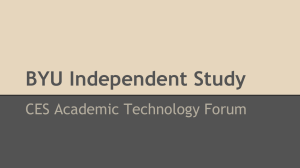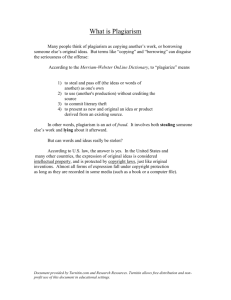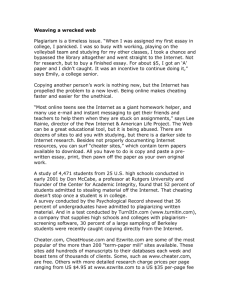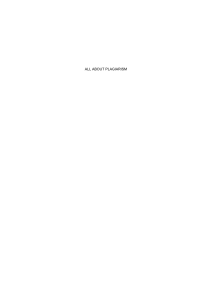Proposal to Implement an Anti-Plagiarism System at Iowa State University David Asuzu
advertisement
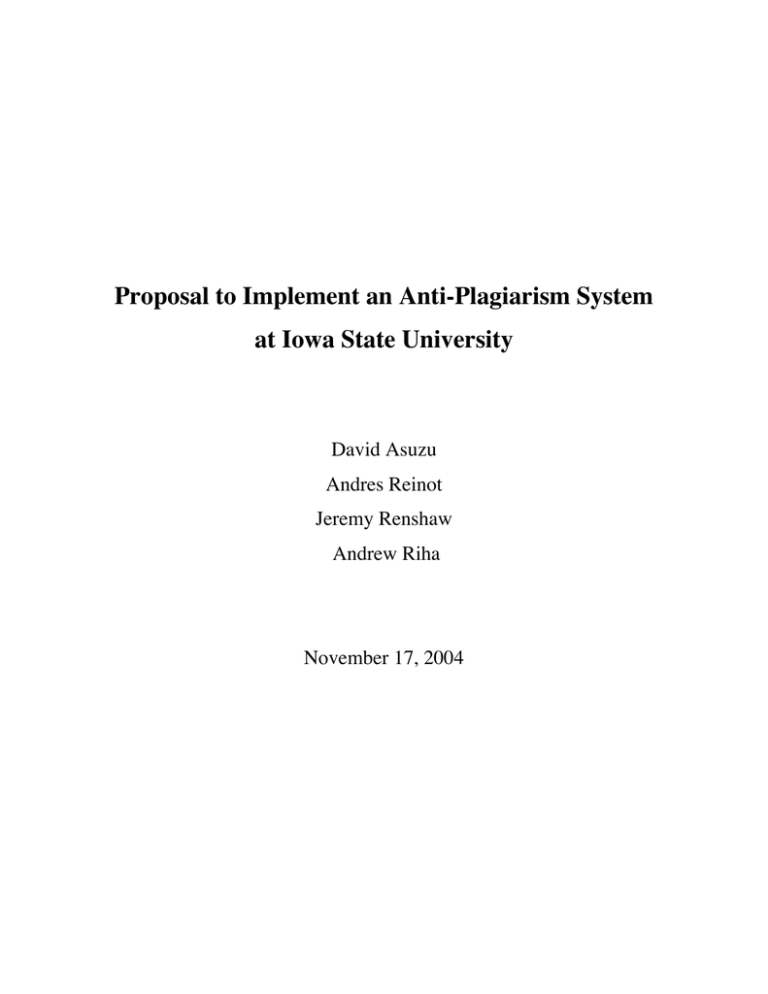
Proposal to Implement an Anti-Plagiarism System at Iowa State University David Asuzu Andres Reinot Jeremy Renshaw Andrew Riha November 17, 2004 Table of Contents ABSTRACT........................................................................................................................................................... II THE PROBLEM .................................................................................................................................................... 1 PLAGIARISM ......................................................................................................................................................... 1 CURRENT STATUS OF IOWA STATE UNIVERSITY .................................................................................................... 2 STATISTICS FROM AROUND THE COUNTRY ............................................................................................................ 3 THE PROFESSOR’S VIEW ....................................................................................................................................... 3 THE SOLUTION ................................................................................................................................................... 4 TURNITIN ............................................................................................................................................................. 4 STUDENT AND FACULTY OPINIONS.............................................................................................................. 7 STUDENT .............................................................................................................................................................. 7 FACULTY.............................................................................................................................................................. 8 FACULTY THAT OVERSEE GRADUATE STUDENTS ................................................................................................... 9 PROS AND CONS OF THE TURNITIN SYSTEM ........................................................................................... 11 PROS .................................................................................................................................................................. 11 CONS ................................................................................................................................................................. 11 RECOMMENDATION........................................................................................................................................ 13 LICENSE AND IMPLEMENT TURNITIN ................................................................................................................... 13 APPENDIX A – SURVEYS ADMINISTERED .................................................................................................. 14 APPENDIX B – CHEATING STATISTICS AT IOWA STATE UNIVERSITY .............................................. 15 i Abstract Plagiarism is a growing problem due in part to the prolific growth of the Internet and the availability of information. In order to stop plagiarism at Iowa State University, we propose that the university implements the anti-plagiarism software called Turnitin. This software scans a document for plagiarism against a large database that contains information from online, physical (print media), and classroom sources. Turnitin is feasible both economically (costing only $.31 per student per year) and morally since authors will be given credit for their work. Furthermore, Turnitin would be beneficial to Iowa State students by increasing the value of an education from Iowa State University and in turn making students more marketable in the workplace. ii The Problem Today, the pressure to succeed weighs heavily on many students. The grades they get today can determine their futures. Students with higher grades generally receive higher paying jobs or get into better graduate and professional schools. With such concerns in mind, many students are pressured into cheating – a quick and easy way to get better grades. This is not only wrong, but it is also unfair to the other students who study and work hard for their grades. Cheating should, therefore, be stopped. Plagiarism Plagiarism is one of the most common, yet most difficult to catch forms of cheating. Students commit this offense outside of class, away from the professor. It can be as simple as a copied paragraph or un-cited source, and as much as an entire paper, thesis, or research paper. Plagiarism is one of the most hurtful forms of cheating, both to the student and to the person from whom the information is stolen. With vast resources available on the Internet, people can search through millions of documents to find (Source: asu.edu/it/fyi/insideit/2003/05/article4.html) exactly what they want. Sadly, a professor does not have the time to search through tens of millions of web pages to catch every offense. Though efficient search engines do exist, they are not tailored to search online information in addition to print sources for copied phrases, paragraphs, and papers. Furthermore, it is impossible for a person to search the vast amount of information available for plagiarism; computers must perform this search. In addition, the computer system must check print as well as online sources to be fully effective. 1 Thus, a system with the above-named characteristics would be needed to effectively catch those who plagiarize. It would need to be fast, efficient, reliable, and within a university’s budget. A system with these traits would be a very serious deterrent to anyone considering plagiarism and an effective means of catching those who choose to plagiarize. Current Status of Iowa State University The Office of Judicial Affairs is responsible for handling all of the reported cases of cheating at Iowa State University. Each year, a university the size of Iowa State will have an average of approximately 2000 reported cases of cheating, many of which are plagiarism. Though it is hard to catch, once a matching document is discovered, the infraction becomes apparent and is difficult to deny. At Iowa State University (ISU), 154 cases of cheating were reported for the 20032004 school year and over 90 percent were held responsible for the infraction. This number concerns Judicial Affairs, since it is apparent that many professors seem to be handling cases privately instead of reporting them. While it may appear benevolent of the professors to take students aside privately for discipline, it may not help the students learn from their mistakes. For instance, a student may be caught cheating 10 times during his or her career at ISU, but as long as these 10 infractions were with different professors who did not report the incident, no pattern will be established and the student will get off with the very minimum penalty as if each separate case were the very first. Due to this unfortunate oversight, the Office of Judicial Affairs is urging professors to report any case of cheating, no matter how minor. 2 Statistics from Around the Country Statistics from around the country show that cheating is on the rise. For example, a study was conducted in 1996 showing that number of engineering students who had admitted to cheating at least once during college was 82 percent – an increase when compared to 58 percent in 1964. In another recent survey conducted by Prism magazine, 1/3rd of college professors had been aware of at least one case of cheating in the last two years and had done nothing about it. The Professor’s View One problem professors face in the case of cheating is that many cases are difficult to catch. The only way to easily catch most forms of cheating is in the most extreme cases, such as a student arriving at the right answers to the wrong version of the test, or a student copying a paper that the professor has already read. For this reason, many professors do not consider it worth their time to check each source and search each line of a paper for matches on the Internet – it is too time consuming. For professors to accurately catch cheaters, a new, efficient system needs to be implemented. Another problem professors face is the fact that the entire burden of proof lies in their hands. The student needs only to establish a reasonable doubt to be cleared of wrongdoing. This is another hurdle that professors do not care to encounter. Recently, a professor at the University of Florida caught one of his students who had copied another student’s work, but the plagiarizing student was able to escape responsibility by declaring that it was a coincidence. If a reliable, computerassisted system were available, the student could have been held responsible for his or her actions. 3 The Solution We have presented numerous statistics that identify a problem with plagiarism among universities around the world, and it is apparent that additional steps need to be taken to prevent plagiarism. We believe that the solution for Iowa State University lies in the implementation of an online anti-plagiarism system called Turnitin. Turnitin Turnitin is a service that checks papers submitted to it for plagiarism. Turnitin began in 1996 when a group of researchers at UC Berkeley created computer programs to monitor the recycling of research papers in their undergraduate courses. With interest spurred, the researchers teamed with mathematicians and computer scientists to create Plagiarism.org, which eventually transformed into the service known today as Turnitin. When a paper is submitted to Turnitin, Turnitin proceeds to compare the submitted paper to its proprietary database, which includes archived Internet information, books, journals, and papers that were previously submitted. As a matter of fact, the Turnitin database has one of the most current and extensive copies of the Internet available. Therefore, Turnitin, with its large database of information from multiple sources, is able to accurately and effectively pinpoint plagiarism. The Turnitin service has received wide acclaim by numerous media organizations such as CNN, the New York Times, the BBC, and USA Today. This praise can be accredited to not only the system’s ability to detect plagiarism, but also to the system’s ease of use. Turnitin is very simple to use, but detailed manuals exist online if questions arise during the process. 4 The Turnitin website contains detailed instructions for its use, and we will now highlight the main components of the process. After a teacher creates an area for students to submit their papers to, a student navigates to the Turnitin website and is presented with the following dialog box in order to upload a paper to the database: (Figure 1. Dialog box to submit a paper to Turnitin. Source: http://www.turnitin.com) After the file has been uploaded, Turnitin compares the paper to all the information in its database. After the process has completed, Turnitin generates a report that details what it thinks is plagiarism and the source from where it thinks the information is plagiarized. The search algorithms are complex and constantly improving, and in addition to being able to detect plagiarism by a person’s use of exact phrases from a source, Turnitin can also detect plagiarism in similar passages despite significantly altered text. Moreover, Turnitin has been programmed to ignore trivial word combinations through extensive analysis of language patterns. 5 A sample report with passages of text that Turnitin thinks is plagiarized is shown below: (Figure 2. Sample report from Turnitin. Source: http://www.turnitin.com) If a professor has setup Turnitin to allow resubmissions, a student is able to use the plagiarism report to correct any plagiarism issues before resubmitting the paper for grading. This is what many professors choose to do, as it gives students a chance to correct any honest mistakes. Following the submission of a paper to Turnitin, professors are able to grade the paper online. Additionally, professors can attach comments to different sections of a submitted paper, thereby allowing students to obtain the necessary feedback. As it applies to Iowa State University, it is important to note that Turnitin can be integrated with WebCT, an online course management system that Iowa State already licenses. A link to the Turnitin website will appear on a course’s homepage in WebCT after the professor activates the Turnitin plug-in, and this will then allow use of the Turnitin system. 6 Student and Faculty Opinions Student These survey results were taken from 125 students selected randomly from different majors and levels of education. All of the students received no prior warning on the content of the surveys in order to keep their responses as original as possible (see Appendix A for the student survey). 37% of students surveyed said they felt plagiarism is a problem at Iowa State, and 12% admitted to having knowingly plagiarized in the past. These results differ markedly from the number of cases of plagiarism reported with the Office of Judicial Affairs. Out of 26,380 students enrolled for the 2003-2004 academic year, only 124 cases of plagiarism were reported (see Appendix B). It can be concluded that many cases of plagiarism at Iowa State go undetected and unpunished. Is plagiarism a problem at ISU? Have you plagiarized before? Yes 12% Yes 37% No 63% No 88% Have your classes used WebCT? Do you like the idea of Turnitin? No 6% Yes 40% No 60% Yes 94% 7 It is unfair to the remainder of the student population at Iowa State if students who plagiarize are not caught and penalized. This fact was reflected in our student survey results. 40% of the students agreed that inexpensive antiplagiarism software incorporated with WebCT would be beneficial at Iowa State, even though we implied that they would have to pay 31 cents per semester to fund this software. The results would have been even more favorable if we had educated the students on the usefulness and ease of use of the software. Iowa State is recognized for its high academic standards. These standards are maintained by requiring student to work very hard and produce original results. Our survey results show that there are many students at Iowa State who are willing to pay extra money to purchase software that will detect cases of plagiarism and help ensure that the academic standard of their institution is maintained. Faculty Twenty-two faculty members of the English, History, Philosophy, Business, and Material Engineering departments were surveyed for their thoughts on plagiarism at Iowa State University (see Appendix A for the faculty survey). The following is the set of results from that survey. Have you used WebCT in a class? Have you ever suspected plagiarism? No 9% Yes 27% No 73% Yes 91% 8 Would you benefit from Turnitin? Unsure 9% No 23% Yes 68% Professors surveyed also commented that a system like Turnitin would help focus the instructor’s role towards instruction and away from policing the class. Additionally, some professors stated that as an alternative to a system like Turnitin, some faculty members have found it easier to design assignments in a way that makes it hard, if not impossible, for students to plagiarize. Faculty that oversee Graduate Students Four professors from the Biology, Mechanical Engineering, Human Computer Interaction, and Material Engineering departments were interviewed in person about the problems plagiarism poses on graduate research and work such as theses and published papers. All expressed genuine concern about plagiarism in published academic works. Plagiarism in the classroom is one thing, but when it is discovered in a published journal, it can leave a black mark on the student’s record as well as his or her major professor, and it can also discredit the reputation of the university. Dr. James Oliver, director of the Human Computer Interaction program, believes it is all too easy for students to plagiarize within the academic community. Dr. Oliver spends much his time proofreading graduate papers, but he admits that he simply does not have the time to check all cited sources for plagiarism. Citations for a graduate thesis or PhD dissertation can number in the hundreds, and it is not 9 possible for one person to check them all. Dr. Oliver, as well as other professors in the LAS and Engineering colleges, have expressed genuine interest in the Turnitin software and the services it provides. The large portion of time they already spend checking graduate papers for plagiarism could never match the thoroughness and efficiency of a system like Turnitin. All professors interviewed that oversee graduate students have, at one point, suspected graduate students of plagiarism in major published works, and all of those professors admitted that it is only possible to catch the offenders in the most obvious of cases. In cases of plagiarism detection, professors tend to rely on lingual cues, such as an inconsistent writing style that can throw red flags, and only then do they pursue the means to report plagiarism. One professor recalled a foreign graduate student who could not speak English nearly at the level of some of the papers he was turning in. The professor employed the same basic techniques that Turnitin features – he searched for key phrases and sentences on the Internet. As a result, he found large paragraphs of text pulled straight out of other published works. “I use the same tricks, but with a much smaller database and far less thoroughly,” he said. It should be noted, though, that with slight editing on behalf of the student, it might be possible to trick even the most keen, watchful professor. All professors interviewed expressed the need for and their willingness to seek out plagiarism in student work, but they simply lack the time and resources to do it. Turnitin would be an indispensable tool for them, and a valuable, thorough resource for the faculty to ensure the quality and credibility of work published under the name of Iowa State University. 10 Pros and Cons of the Turnitin System Pros Turnitin has many benefits, the most notable being its ability to promote academic honesty by detecting plagiarism. One student we surveyed summarized the attitude of most college students toward plagiarism: “Every child at a young age plagiarize[s] when asked to write an essay.” He continued by explaining that during high school, students learn that they can get away with copying other people’s work, and this attitude often continues onto college. If students are not expunged of this attitude while in college, they will go out into the marketplace, hospitals, and law chambers believing it is fair to get away with a degree of dishonesty. It is part of the university’s responsibility to train students to be good citizens, and that responsibility includes detecting and punishing dishonesty. The responsibility of detecting and reporting plagiarism, however, lies not on the Office of Judicial Affairs, but with the professors. Many professors do not seem to report plagiarism for fear of potential lawsuits from students or their families, especially in cases where the professors cannot determine the extent of plagiarism or the source of the plagiarized materials. With Turnitin, professors can easily find out exactly what words were plagiarized and their original source. This will give them concrete evidence in a case of plagiarism, and it will make them more willing to report plagiarism to the Office of Judicial Affairs. Additionally, Judicial Affairs could recommend that professors submit printouts of the plagiarism reports from Turnitin to ensure that all cases of plagiarism are reported and appropriate measures are taken. Cons Cost is an important issue when it comes to allocating State funds. Professors and students need to be trained on how to use the software, and this requires time, money, and some assistance from the Academic Information Technologies (AIT) department. In order to license Turnitin, an investment of $500 per year plus 60 11 cents per student is required. However, if this cost were to be split among the 26,380 students enrolled for Fall 2004 at ISU, each student would only have to pay an additional 62 cents per year, or 31 cents per semester. Also, because of a recent partnership between Turnitin and WebCT, students and faculty alike can easily gain access to the Turnitin website by clicking on a link on their WebCT homepage. 94% of the students and 27% of the faculty we surveyed said they had already used WebCT for a previous class. They are not likely to require further extensive training in the use of Turnitin. Turnitin is a completely computerized system, and some professors still prefer to grade hard copies of papers because it is easier to make comments on paper and computer screens can be hard on the eyes. While this is true, it should be noted that Turnitin is anti-plagiarism software, and professors do not need to use Turnitin to grade papers. Many professors already require students to submit a copy of their papers electronically for the purpose of maintaining a backup copy. With Turnitin in place, students will be required to upload a copy of their paper to the Turnitin site in order to make it easier for professors to check for plagiarism – the professor may still collect hard copies from the students if he or she desires. 12 Recommendation License and Implement Turnitin We recommend that Iowa State University purchases a license for Turnitin and implements the system with infrastructure that is already in place: WebCT. Not only is Turnitin relatively cheap (a cost of 31 cents per student per semester), it is also easy to use and extremely effective in detecting plagiarism. With Turnitin in place at Iowa State University, the quality of education at Iowa State will increase and there will be a greater desirability for an Iowa State diploma in the marketplace. Plagiarism is a growing problem that needs to be stopped, and Turnitin can help Iowa State University achieve that goal. 13 Appendix A – Surveys Administered Plagiarism is the improper use of another person’s writing or ideas. (turnitin.com) Please Mark Y or N in the blanks below Y __ N __ __ __ To the best of your knowledge, have you ever been involved in plagiarism? __ __ Have any of your classes used WebCT? __ __ Do you think that an inexpensive anti-plagiarism program (costing 31 cents per student per semester) incorporated with WebCT would be beneficial at Iowa State? Do you think plagiarism is a problem at Iowa State? Additional Comments: Figure 3. Survey Given to Students. Plagiarism is the improper use of another person’s writing or ideas. (turnitin.com) Please Mark Y or N in the blanks below Y __ N __ __ __ Have you ever used WebCT for a class you have instructed? Have you ever suspected a student of plagiarizing? If so, how did you handle it? How many times, if any, have you reported plagiarism to the Office of Judicial Affairs? __ __ Would you benefit from an easy to use anti-plagiarism system integrated with WebCT? Additional Comments: Figure 4. Survey Given to Faculty. 14 Appendix B – Cheating Statistics at Iowa State University Students Caught Cheating in the 2003-2004 School Year (By College) 120 104 100 80 60 40 20 15 12 10 5 5 3 Agriculture Educ/Vet Med 0 LAS Engineering Business Design FCS Students Caught Cheating in the 2003-2004 School Year (By Class Status) 60 56 50 44 40 30 20 20 22 11 10 1 0 Freshman Sophmore Junior Senior 15 Graduate Special Students Caught Cheating in the 2003-2004 School Year (By Gender) 120 100 100 80 60 54 40 20 0 Female Male 16


